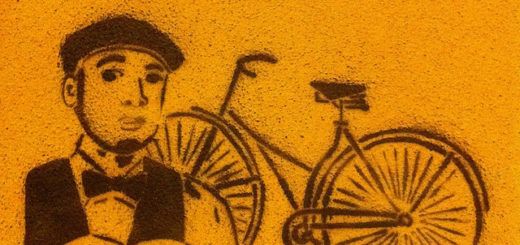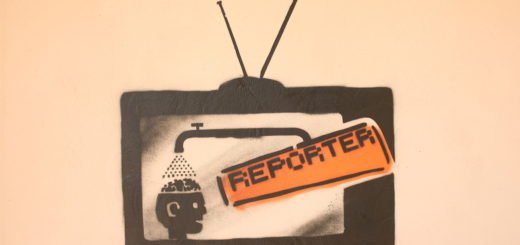Pirates break all the rules… and we cheer
 This summer, I’ve seen the pirate flag, the jolly roger, more often than I’ve seen the Stars and Stripes. The distinctive black flag usually includes a white skull with swords, or bones, crossed underneath.
This summer, I’ve seen the pirate flag, the jolly roger, more often than I’ve seen the Stars and Stripes. The distinctive black flag usually includes a white skull with swords, or bones, crossed underneath.
On the first Saturday in August, the jolly roger fluttered above the “Fiji” fraternity house near the University of Texas. It was slapped over pirate-themed booty at nearby Toy Joy. It covered a shower curtain at Wheatsville Co-op.
At Headhunters nightclub downtown, the jolly roger was being waved by Captain Phleabag, 33, the lead singer of the Jolly Garogers. To visualize Phleabag, think of singer Adam Ant during his ’80s pirate period.
The Jolly Garogers, dubbing themselves Austin’s premier pirate band, “All shows rated aRrrrr,” are displaced pirates from 1675. They dropped through a Bermuda-Triangle time-warp into current-day Austin. The time warp froze their age at 33.
Their tune “Pirates of the Caribbean” directly references today’s most visible pirates.
As of the first weekend in August, “Pirates of the Caribbean: Dead Man’s Chest” had pillaged nearly 800 million bucks from wallets worldwide. According the CIA factbook, that’s millions more than the combined 2002 GDP of three Caribbean nations: Montserrat, Saint Kitts and Nevis, and Saint Vincent and
the Grenadines.
Though film critics warned the public away from the second installment of the “Pirates of the Caribbean” trilogy, “Pirates” booty has been furiously pouring into Disney’s treasure chest. How could it not? It’s a pirate yarn with hunkalicious Johnny Depp.
Pirates have long made a good vehicle for stories. During the golden age of piracy (1695-1725), pirates were occasionally captured and tried. In “Rum, Sodomy, and the Lash: Piracy, Sexuality and Masculine Identity” (NYU Press 1999), Hans Turley tells us the London public snatched up accounts of sin-sational pirate trials. Perhaps it was like reading the Malibu police department’s account of Mel Gibson’s recent arrest?
Eighteenth century pirate tales were accompanied by forerunners of celebrity “mug shots,” dramatic illustrations of fierce pirates. Turley includes a 1736 picture of uberpirate Blackbeard with dreadlocked whiskers. It’s a picture eerily similar to Depp’s “Captain Jack Sparrow.”
Turley points out the magic of mythology transformed the pirate from a criminal terrorizing the shipping trade into today’s romantic anti-hero. Amazingly, “pirate mythos” began back when a stinky pirate swinging a stolen sword might suddenly snatch your sailing ship.
This “pirate mythos” doesn’t apply to modern pirates. Pirates in Africa are terrorizing ships along the 1,900-mile Somali coast. Modern pirates hold ships and crews for ransom, but they lack the appeal of classic pirates.
Classic Pirates were the original bad boys. They were outlaws and rule-breakers. Like Old West gunslingers, biker-gangs and some rap stars, pirates existed outside conventional society. For academics, this makes pirates “The Transgressors” or “The Other.”
The current popularity of “old-school” pirates is because they represent outsider-ness and freedom from rules.
This pirate embodiment of freedom is important, as we have too many rules. Traffic laws. Uppity restaurants requiring shirts and shoes for service. Your homeowners association banishing your beloved shiny, golden, foot-high statue of a squirrel clutching an acorn, on the dubious grounds of “taste.”
In my quest to understand why the jolly roger is everywhere, I talked to folks embracing “pirate mythos.”
Xander Brown, 18, was one of eight people gathered at Dragon’s Lair for a hybrid WizKids card/miniature game, “Pirates: The Constructible Strategy Game.”
Brown and company were busily inspecting their cards and ships. Earlier, they had punched plastic parts from “Pirates” cards to build miniature ships.
“I’m just sort of drawn to pirates as a culture,” Brown said. Indeed, Brown wore his pirate leanings on his sleeve. His vaguely piratelike ensemble included: a red-bandanna tied around his head, a long-sleeve black-shirt, baggy brown pants and black Croc sandals.
“Pirates represent something masculine and cool,” Brown said. Brown introduced friends Gardner Williams, 18, and Michael (no last name), 18, to “Pirates.”
“Pirates are kind of out there. Pillage, burn, be a pirate,” Williams said.
Brown and Williams have long been interested in pirates. They excitedly recounted reading Shakespeare’s “Othello” in Anderson High’s senior English class last year on”International Talk Like a Pirate Day” (Sept. 19). Shiver me English-major timbers.
Perhaps the appeal of pirates might be best summed up by a pirate.
“The old days of the freedom of being on the sea. No rules. No rules. No rules. I think that’s what people like pirates for,” said Redbeard, 33, lead guitarist for the Jolly Garogers.
I doubt today’s pirates, plying their criminal trade in Africa, will ever enjoy the celebrity of “old school” cutlass-wielding pirates.
They just don’t have the style.
Or the parrots.






















